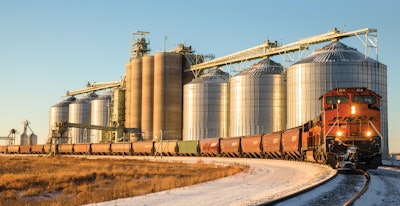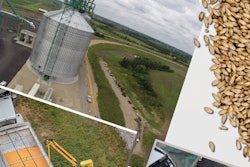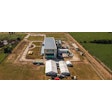
Railways are a vital mode of transportation for U.S. grains. Although 2019 saw fewer grain shipments by rail due to low export demand, spring flooding and other factors, rail is still king when it comes to moving ag commodities across the country.
The demand for rail access helps determine where new grain handling and shuttle loading facilities are built and the railroad is one of the first contacts made when an organization begins considering a new location. Railroads often act as an engineering partner, assisting with applicable permitting requirements and even helping companies secure capital for new projects. After that, they continue to provide transportation services and railcars to the facility.
Although the industry is deeply reliant on rail transportation, its relationship with the railroads could also be described as strained.
Four railroads — BNSF Railway Co., CSX Transportation, Inc., Norfolk Southern Railway Co. and Union Pacific Railway Co. — together control about 90% of all U.S. freight traffic. Since 2007, dozens of companies including commodities traders, ethanol producers, auto manufacturers, and food and beverage companies, have come together to file class action lawsuits accusing the railroads of violating antitrust laws by conspiring to enforce rail fuel surcharges, resulting in an across-the-board rate increase.
Denying the allegations, the railroads have defended themselves in court and in 2017, a federal district court denied class certification. In 2019, a U.S. Court of Appeals for the D.C. circuit sided again with the railroads. Shippers are now filing individual lawsuits making the same claims as the original lawsuit.
While the railroads battle against some of their customers’ allegations, they also continue to serve an important purpose for the grain handling industry. Revenue from the agriculture sector continues to grow and the railroads say they’re investing it back into rural improvements.
Feed & Grain compiled a roundtable with feedback from representatives at BNSF, CSX and Union Pacific (Norfolk Southern did not respond to inquiries), covering 2019 performance, their commitment to investing in rural infrastructure, freight cars and locomotives and how Positive Train Control helps make train operations safer (see below).
F&G: Describe the company’s change in agriculture volume throughout 2019.
BNSF: First quarter volume reached approximately 276,000 units of agricultural products. Fourth quarter volumes were slightly higher at approximately 290,000 units with a total of approximately 1,146,000.
CSX: Agriculture and food shipments on CSX increased 4% from the first to the third quarter, but a year-over-year quarterly comparison is a more useful trend indicator. Comparing the first quarter of 2019 to the same period in 2018, grain and feed shipments were up 7%. For the third quarter, the year-over-year increase was 6%. In fourth quarter grain and grain products were essentially flat.
UP: Due to flooding in the first half of 2019, Union Pacific saw a rail volume increase to the Gulf, instead of shipping through the river. We saw some growth in domestic corn volume to Texas and Arkansas, due to less local corn production, in third quarter 2019.
F&G: How is your agriculture sector performing in 2020?
BNSF: Agriculture will always be a strength for BNSF. Barring outside interventions like tariffs, grain will always be cyclical, but as population increases and the world needs more food, it will continue being a significant part of our business. Weather and field
conditions in 2019 played a part in lower crop yields for 2020. Coupled with continuing trade concerns, price pressures have caused a shift from our international exports to higher shipments to domestic and Mexican markets.
CSX: Despite challenges related to crop conditions and trade issues, grain shipments on CSX are up 2% through the first two months of 2020 vs. the same period in 2019. This growth can be attributed to a diverse portfolio and a strong service product.
UP: Fewer U.S. grain exports impacted Union Pacific’s agricultural shipments and hopefully the trade deal with China will have a positive impact on agricultural imports and exports.
UP’s domestic business is very mature and continues to be a strong market for shippers. Union Pacific has grown its domestic footprint over the last 10 years to provide a more consistent grain outlet for our customers.
F&G: What significant investments were made last year?
BNSF: In 2019, BNSF invested $3.6 billion into its network, the largest component of which supported maintenance and expansion projects. This means BNSF is well positioned for growth and ready to take advantage of opportunities to safely and reliably meet customers’ agricultural shipping needs in 2020 and beyond.
BNSF is continuing a multi-year double-track expansion project in the Hauser-Spokane corridor offering greater capacity in the Pacific Northwest for agricultural products customers. Part of that project includes the construction of a new bridge across Lake Pend
Oreille to reduce bottlenecking. Last year BNSF also expanded the Eagle Pass, TX, border gateway by adding new staging tracks to handle growth into Mexico. BNSF also replaced more than 1,000 older hopper cars with new, high-cube, 286,000-pound capable cars that are shorter in length.
CSX: In 2019, CSX invested more than $1.6 billion to maintain infrastructure and improve overall fluidity for customers across all market segments. The vast majority of this investment was dedicated to maintaining and improving our network assets.
UP: Union Pacific invested approximately $3.2 billion in capital expenditures on infrastructure replacement, equipment and capacity/commercial facilities.
Union Pacific continued implementing operating efficiencies in 2019 that resulted in improved service reliability for customers. These efforts will continue as we work to consistently provide safe, efficient and reliable rail service.
F&G: What investments in 2020 will impact grain shippers?
BNSF: BNSF’s 2020 capital investment plan reflects its emphasis on keeping the network in the best condition ever, as well as meeting agricultural customers’ needs. The largest component of this year’s $3.4 billion plan — $2.55 billion — will primarily be for replacing and upgrading rail, rail ties and ballast and maintaining the rolling stock. This year’s maintenance program will include approximately 11,000 miles of track surfacing and/or undercutting work. It will also include the replacement of approximately 489 miles of rail and nearly 2.7 million rail ties.
CSX: CSX plans to invest $1.6 to $1.7 billion in 2020. The investment will be targeted for projects that continue to support improved service reliability. This includes re-investing in our track structure, rebuilding freight cars and locomotives as needed, and using technology to drive efficiencies. In addition, CSX continues to invest in positive train control to improve the safety of our operations.
UP: Union Pacific plans a base capital investment $2.95 billion in 2020. An additional $150 million is allocated for strategic siding extensions to accommodate longer trains. ■
PTC For Safer Rail Operations
The Rail Safety Improvement Act of 2008 called for Class I freight railroads to install Positive Train Control — technology that prevents train-to-train collisions; derailments caused by excessive speed; unauthorized incursions by trains onto sections of track where maintenance activities are taking place; and the movement of a train through a track switch left in the wrong position — by the end of 2015. However, in 2018 the DOT granted the leading four railroads an alternative schedule to fully implement PTC.













